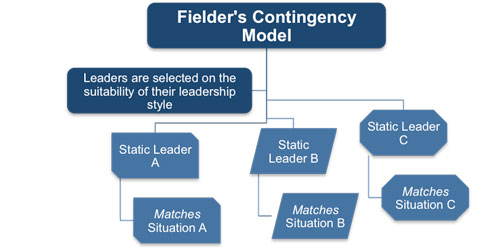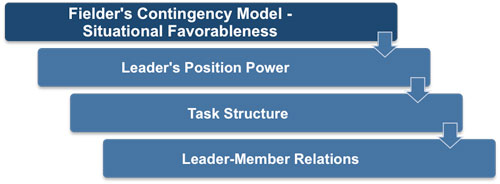Fiedler's Contingency Model
Developed back in the 1960's by Fred Fiedler, Fiedler's Contingency Model is an interesting look at leadership styles and how different approaches can lead to very different results depending on the circumstances. As the term 'contingency' would indicate, this model is based on the idea that rather than having a single leadership style for all circumstances, the best approach is to be able to vary the leadership that is provided based on the group and task at hand. However, Fielder argues in this model that a specific leader is only able to lead in one fashion, meaning that another person will need to be tasked with the job if a different leadership style is required.
Right away, there are some elements of this model that make sense when you think about how they will be applied. Most people would agree that a 'one size fits all' approach is not going to be effective when it comes to leadership - rather, it will take a variety of styles and techniques to achieve success in the long run. However, the idea that an individual leader is unable to change their ways based on the needs of their team is one that will likely be argued by many. Regardless of where you stand on this topic, the model is certainly worth taking a closer look at for its many interesting insights.
 |
The Static Leader
Starting with the idea of a leader who is unable to change his or her ways, we see that Fiedler uses a scale to determine what kind of leader an individual will be (or already is). The methodology for making this determination is quite interesting, and it yet another part of the model which is likely be to the basis for some level of debate. The scale that is use for making this determination is called the 'Least-Preferred Co-Worker' scale. Basically, this scale asks a series of questions that the leader is supposed to answer while thinking about the person that they have worked with over the years who they would consider to be their 'least favorite'.
In order to arrive at a result, the leader is supposed to rank that person on a scale of 1-8 on a variety of personality traits such as Unfriendly to Friendly, and Hostile to Supportive. There are 16 of these rankings to complete, after which the leader will be left with a score that they can use to identify where they fall within the leadership spectrum. Those who receive low scores on this scale are more focused on tasks as opposed to relationships, according to the model. Alternatively, a high score on the test means that the leader in question is more focused on building relationships with their teams.
The idea that these numbers are 'set in stone' is something that many people will disagree with. It seems logical that leaders will develop and evolve over time, potentially changing the score that they would receive on this scale. Also, depending on the person in question whom they were thinking about while answering the questions, the results could be skewed based on one strongly negative memory.
 |
The Other Half of the Puzzle
Making up the other half of this leadership model is the idea of 'Situational Favorableness'. This is really where the contingency portion of the model really comes into play. There are three factors which fall under situational favorableness, and each has a say in how a certain type of leader will fare in a given situation.
• Leader's Position Power. How much power is the leader being given in a situation? Are they the final word when disputes arise, or is the level of management above them that will dictate decisions down to the leader? The model classifies these rankings into two categories, simply 'Strong' and 'Weak'. A strong leader is one who has a high level of power within the organization, while a weak leader is controlled from above to a greater degree.
• Task Structure. There are two kinds of tasks according to this model - structured and unstructured. Obviously, structured tasks are detailed and clear as to what they expect from each of the team members. Unstructured tasks may be open ended or undefined in terms of the goals and missions for the team.
• Leader-Member Relations. The title pretty much sums it up on this point. How good is the relationship between the team members and the leader? The type of project that is being undertaken, and the ranking on the other two points on the Situational Favorableness scale will determine what kind of leader it takes to match up with the job. While most of the time a stronger relationship between leader and team is going to be preferred, that will not always be the case.
When you start to plot out all of these various rankings, you can reach a table which highlights what kind of leader is going to be best suited for a given situation. Using the three factors categorized under situational favorableness, and the two possible states for each factor, the table will include eight possible leadership scenarios. Four of those will be best suited for a leader with a high score on the Least-Favorable Co-Worker questionnaire, and four will be better suited for a leader with a lower score.
While Fiedler's Contingency Model is an interesting look at leadership styles and their effectiveness in certain situations, the limitations are pretty evident right from the start. Basing a person's leadership style on their interactions with one single co-worker could potentially lead to a misleading outcome, and each of the three factors probably aren't as black and white as they are required to be in order to use this model. However, using this model to get an idea of what kind of leadership style you use, and what circumstances will be best-suited for you to manage, is an opportunity to gain insight and perspective. The Contingency Model can help you think about how you manage, and why you might be more successful in some situations than in others.
You may also be interested in:
Action Centered Leadership | Blake-Mouton Managerial Grid | Dunham and Pierce's Leadership Process Model | Fiedler's Contingency Model | French and Raven's Five Forms of Power | Hersey-Blanchard Situational Leadership Theory | Tannenbaum-Schmidt Leadership Continuum | Lewin's Leadership Styles Framework | Path-Goal Theory | Zenger and Folkman's 10 Fatal Leadership Flaws.



